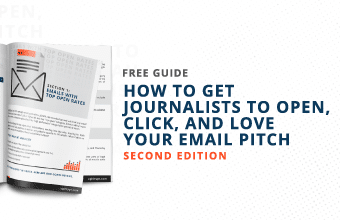Prior to jumping to the PR side of the fence from the newspaper wall, I was a reporter and editor at New York City dailies and wire services.
As a reporter and editor, I always took into account the news value, the feature story possibilities or the uniqueness of a story being pitched to me. And unlike many journalists, when in doubt about a pitch, I would always err on the side of the public relations person. But doing that was often a mistake because after spending time researching a story, to use a phrase now en vogue, “there was no there there.”
There were various reasons the reporting resulted in no story
A few were:
- What was pitched turned out to be entirely promotional—suitable as an advertisement, not as a news story
- The proposed story lacked both hard and feature news elements—the news value had been previously covered when an initiative was initially announced and the new pitch did not contain any new information that would make it useable as a hard news or feature article
- Neither the PR person nor the interview source would answer questions or provide the requested back-up that confirmed what they said—when asked to provide additional information, the PR person never got back to me (a too common occurrence), and often when asked for facts to substantiate the PR person’s claims there were none.
- Instead of proposing a story that would work for both the client and the media, the offerings were entirely client-centric—and too often account teams fall back on past successful programs, attempting to disguise them with a new twist and a celebrity spokesperson. Usually, experienced journalists who deal with PR people easily recognize these “face-lifted oldies,” resulting in poor, few or no hits.
- Often, PR practitioners fail to remember that “new” is the essential part of “news” for major media journalists—if there isn’t new hard news to report, PR programs must include innovative feature approaches.
- Also, on occasion, when a pitch was rejected, some PR people would ask the journalists to offer suggestions that would make the pitch usable—doing so upsets some reporters, including one who told an account person, “Not only do you want me to help you, but you want me to do your job and tell you ways that would get me to help you.” Then she hung up and said, “There’s another PR person that’s on my ‘do not reply to’ list.”
Unlike some journalists, being sympathetic to the plight of PR people, if I thought a pitch had the making of a good story, I would always suggest to the PR person what elements were needed to turn the pitch into a story—with one exception: That was when a PR person would say, “If I don’t get a story or interview about this client in the next week or so, I’m going to lose my job.” In effect, that PR person was making me responsible for his or her being fired, and I would respond by saying, “I’m concerned enough about my own job”—which was true with the declining number of newspapers in New York City.
Almost immediately after joining a PR firm, I noticed a major reason that PR programs failed
Many had an unappealing “sameness” to journalists and too often account teams created programs to satisfy clients without considering how it will play to the media. That’s a sure way to achieve meager to nil publicity results.
Other reasons for meager results were what I call the “client syndrome.” In an effort to satisfy the client, staffers include in programs everything the client wants. Doing so is self-defeating because many client marketing managers who control budgets are not conversant with consumer journalists’ needs. (It’s okay to do so as long as the elements dictated by the client are not included at the expense of more realistic ones and are not acted on.)
In one instance, the top public relations executive, by title, of a prestigious national trade association—a gracious and kind elderly gentleman whose job was to meet, greet and host association members when they visited New York—asked me if I could get a columnist, who was popular many years ago when the exec had media contact, to attend an event, even though the journalist had died several years earlier. My PR contact, who was running the publicity department, said, “Don’t tell him he died. Just put him on the list of invitees for the reception.” I did. But, needless to say, I couldn’t get that journalist to attend or do a story.
Another reason for failure that I saw early on was the “big idea” approach
That’s when account teams become so enamored with their plan that elements of a program that might appeal to journalists are given short shrift to make room for the “big idea.” This was especially true when young account teams were afraid to challenge the recommendations from their creative departments, who would blame the account team for not being able to make the “big idea” work, even though the suggestion was unworkable because it was grandiose and/or impractical because of budget limitations or simply was lacking in news value.
An additional reason for faulty programming is, to use a political expression, “the wise person approach.”
That’s when a senior person, who knows nothing about the client and was not invited, unexpectedly attends a creative meeting and starts throwing out program elements that have little to do with the client’s wants, but are eagerly accepted by the young awe-struck account team members because of the individual’s title. To paraphrase Tevye from “Fiddler on the Roof,” “Because you have a high title often means you’re right, even when you’re wrong.”
I once had two very high-ranking officers, who hadn’t spent an hour working on a flagship account that I managed for eight years, come into a creative meeting and suggest an approach that was directly opposite of what the client wanted. The reason they did so was because an even higher-titled person from our parent organization, an advertising agency, suggested an approach that might give him the opportunity to pitch the ad side of the account. Since none of the trio knew anything about the client’s marketing plans the suggestion was 180 degrees opposite of what the client wanted.
Because that morning, I had recently been second-guessed by the two PR executives about how I handled a sticky PR situation that they knew nothing about (successfully, I might add), I was not happy to see them and said, “You’ve just disproved the rule that there is no bad idea during a creative situation.” (Since I was managing two major flagship accounts, and was playing a key role in another one—all with huge budgets—and had the complete support of happy clients and was making money for the agency, I knew that there wouldn’t be bad consequences over what I said; bad feelings for a few days. Yes, but bad feelings over a remark in a pressure-filled job—in which you are constantly being second-guessed by higher-ups after you told them that their only knowledge about the accounts is when they looked at the monthly P&L reports—are not unusual.)
Here’s how to make your program more media friendly
- Creating a program that might work for both the client and the media is not that difficult. Account teams can accomplish this by tailoring specific facets of programs to specific media they approach, instead of using a shotgun approach. But doing so entails being exceptionally familiar with those media and being able to develop strong feature approaches. In order to do this, PR agencies have to abandon the “silo syndrome” and call on personnel from other groups that have had success working on similar problems for help.
- Too often account teams fall back on past successful programs and attempt to disguise them with a new twist and a celebrity spokesperson. That’s a good start. But account handlers must remember that “new” or “different” must be the essential part of programs to gain the attention of major media journalists. What works when crafting a PR program is to look at it from the journalists’ viewpoint, providing news and feature elements, some with a long shelf life for long-lead pubs, and making sure the programs work for both the client and journalist. Too often, only the client’s wants are considered. This is best accomplished by having on staff a former reporter or editor to help create the story lines and review and make suggestions about press releases and pitches before they are disseminated. If there is no former journalist on staff, consider engaging a retired one to play that role on a consulting basis.
- PR account teams too often think that having a prominent spokesperson deliver the clients message will assure major coverage. That’s why so many athletes, retired and active, are used as hawkers. Using a prominent athlete creates a “good news, bad news” situation. The “good news” for account people is that pitching the athlete might make it easier to land an interview. The “bad news” is history shows the resulting story often has one line saying, “So and So” is a spokesperson for the XYZ company and the remainder of the story is about the athlete’s career. My suggestion is to hire a personality with expertise in the subject being pitched. Unlike the athlete interviews, it is much more likely that a respected third person expert can work in client talking points. In my opinion, stories without talking points are worthless.
- I also believe it is a mistake to offer the same individual for interviews to all reporters, editors and producers. What I always suggested was to categorize pitches by offering CEOs and presidents of companies for business and financial publications, marketing executives for marketing and ad outlets, and product development personnel for new products, in addition to the accepted outside expert. Even when the subject called for a sports personality, I would avoid the current “star of the day,” because those athletes were seen almost every day by beat reporters. Instead, I would use prominent athletes who were out of the media spotlight for years. They were always welcomed by reporters because nostalgia is a big part of sports coverage.
Developing a program and media outreach that works for both the client and the media begins in the first creative session
A PR tenet that dates back to the days of the PR dinosaurs is that during a creative session, “There is no such thing as a bad idea,” which, when I was conducting the session, I always ignored, because I thought it was a flawed theory and most often generated ideas that had no relevance to the subject being discussed. I came to that opinion after attending several of these “anything goes” creative sessions when I first joined the PR business.
Instead, I opted for a more structured session. Several days prior to the meeting, I would send a list of questions to those invited, telling them that any suggestion they have must relate to those questions, with instructions to send me their written answers the day before the meeting and I would select the suggestions to be discussed. Importantly, as each point was discussed, I would give credit to the person who provided that answer to my question.
After those discussions, I would declare an “anything goes” period and invite any other ideas that didn’t fit the Q&A discussions. The result was a more structured creative session that produced on-target suggestions, but also would leave room for attendees to demonstrate their creativity in the “anything goes” discussions. Believing that good work should always be acknowledged, I wrote memos to supervisors praising the contributions of people who reported to them, which paid off handsomely when many of those account executives reached management level and provided me with project work when I set up my own consultancy. (In one instance, I was told that writing the memo saved a person from being fired.) Conducting a creative session in this maverick style should be done all the time, I believe.
A good, strong pitch should contain all the elements that make for a story
If you have to convince the reporter why your story should be told, you’re starting out with two strikes. But just because your first pitch is rejected doesn’t mean that you can’t approach the same journalist with new approaches.
Personal story: During my days at Burson-Marsteller, BusinessWeek magazine was always a top target. For corporate clients, I would propose stories to the corporate editor. Eventually he left to become the top corporate PR executive at Gillette. One day I received a phone call from him asking if I was interested in pitching the account. He told me that the reason he thought of me was because unlike other PR people, whenever he rejected a pitch from me, I would come back with several other strong angles that made sense for him to consider. And when I pitched a story in person I always had several back-up angles to throw out if my initial suggestion was rejected. Likewise, in a written pitch, I always included several different ways a story could be approached. We pitched and got the account. Caveat: Approaching a reporter a second time about the same story can be disastrous to your relationship if your follow-up approaches are contrived and weaker than your initial pitch. And don’t be a pest. Wait several days before following up.
I’ve been in this business for a very long time and never had a client insist that we had to do things his way. Maybe that’s because the client knew of my background as a reporter and editor, or maybe it was because I never said. “I don’t think that will work” without offering alternative approaches.
However, if you ever have a “do it my way” client, always express your concerns, but never without having alternative program ideas for the client to consider. The client might still not agree with you, but at least you’ll avoid being told, “I don’t see you suggesting anything that’s better than what I’m suggesting.”








